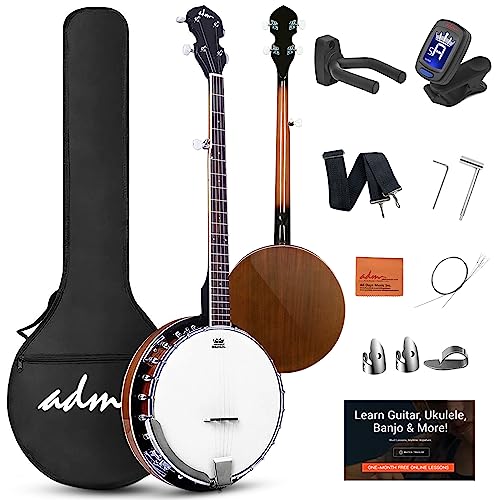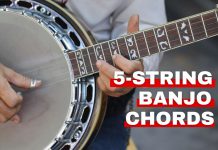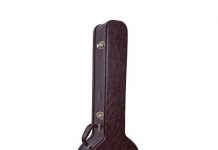There are so many different types of banjos that it can be overwhelming to select which one is right for you. Do you get a four-string banjo or a 5-string? What’s the difference between open back and resonator banjos?
In this article, we’ll take a closer look at these stringed instruments and find out which one is suitable for your playing skills and level. So, let’s get right to it.
Open Back Banjos and Resonator Banjos
When you shop for banjos, you’ll often be asked whether you prefer an open-back or a resonator banjo. So, what’s the difference?
As its name implies, an open-back banjo features an open-back design, which means its chamber is exposed. Since it doesn’t have a back cover, the sound of an open-back banjo is mellow and soft. Its sound level is also lower because the chamber presses against the banjo player’s body.
On the other hand, resonator banjos have a closed back and feature a wooden bowl. This design choice pushes the sound towards the audience. It also produces a louder sound, suitable for blue-grass style plucking.
4-String Banjos
4-string banjos are the most common banjo that you will encounter. They are generally tuned to open D tuning and more beginner-friendly because you’ll only need to play four strings. There are two types of 4-string banjos – plectrum banjos and Irish Tenor banjos.
Plectrum Banjos
Plectrum banjos are a particular type of banjo with a pick attached to the head-stock. They are often used in Hawaiian, country, and bluegrass music because they allow players to strum with their thumbs, an essential aspect of music.
While these banjos can produce an excellent sound, they aren’t typically very versatile since you can’t change the notes that you play on them.
A plectrum banjo is played like an electric guitar with your thumb and index finger. While you can use your entire hand to strum it, a plectrum banjo gives you more variety in what you can play because of its built-in pick.
Fun fact: A plectrum banjo is like a 5-string banjo, but it doesn’t have a drone string. It is also commonly used in Dixieland, bluegrass, and jazz genres.
Irish Tenor Banjos
An Irish tenor banjo resembles a plectrum banjo but with different tuning and length. Most tenor banjo players have their instruments tuned to a viola (A, D, G, C), while others prefer Chicago tuning (E, B, G, D). However, the standard tuning of an Irish tenor banjo is G, D, A, E. You have two options:
- 19-Fret Tenor Banjos: A 19-fret Irish tenor follows a C, G, D, A tuning and is common in traditional jazz music.
- 17-Fret Tenor Banjos: These banjos have a shorter neck and typically have a mandolin and violin tuning (G, D, A, E). 17-Fret tenors are common in Irish and folk music.
5-String Banjos
5-string banjos are much different than their 4-string counterparts. They use a fifth string or thumb string, which allows for additional notes than those on 4-string banjos. They are much more challenging to play, but you can use them for different banjo styles, including Scruggs style, clawhammer, and strumming.
When tuning a 5-string banjo, you will need to change the notes that you play and the string you use. For example, if you’re playing on an open G chord, then all of your fingers will have to reach C and G. This is because you want to be able to play with all of the fingers, not just one. You can easily do it by switching between strings and notes.
A 5-string banjo can be tuned to:
- G tuning (B, E, A, D, G)
- Open C tuning (D, G, C, F#)
- Open D tuning (D, G, A, D).
Fun fact: If you are Mumford and Sons fan, the band uses a 5-string banjo.
Parlor Banjos
Parlor banjos are much more common and easier to find but still take some time to master. They have shorter necks than other banjos, making them easier to play. They also don’t require you to use as much forearm strength as most other types of banjos do because they are smaller in size. These banjos are tuned using the same notes as 5-string banjos but with a drop D tuning (D, A, D, G, B, E).
They are light in weight and easy to carry around.
Long Neck Banjos
Long-neck banjos look much like regular banjos, except they have longer necks. The long neck makes playing chords on a banjo easier than on a short channel. However, they are much more challenging to play than short-necked banjos. The strings of this type of banjo are also closer together than those on a short-necked banjo, which means you will have to stretch less to reach them when playing. They are also known as the big daddy, have three more frets than a conventional banjo, and utilize the same chord patterns as 22-fret banjos. You can also use either gut strings or nylon strings.
6-String Banjos
6-string banjos are also known as “banjos for the rest of us.” The extra strings are used only to play melody notes, making it easier to play than a 4-string banjo. However, it will take some time to learn how to tune this type of banjo.
They can also take more time to play, especially during the transition between chords. You will want to use the same tuning to get a similar sound to 5-string banjos. For example, you can use open D tuning or open G tuning for this instrument.
12-String Banjos
12-string banjos are very popular among folk musicians because of the way they sound with other instruments.
12-string banjos are tuned the same way as 6-string banjos. However, they do have some unique features that you won’t find on other types of banjos. For example, to reduce fatigue on your wrists as you play them, 12-string banjos often have shorter necks than others. They also have shorter strings, and their frets are also closer together.
Other Types of Banjos
In addition to the mentioned 4-string, 5-string, 6-string, and 12-string banjos, you will find hybrid banjos, which are a fusion of a banjo and another stringed instrument. Here are other types of banjos,
Mandolin Banjos or Banjolin
A mandolin banjo has the same four strings as a mandolin or mandola. They also feature the same frets as conventional banjos, but their tuning differs. For example, you can use open G tuning with these instruments. As with most banjos, they also come in various types of wood, such as mahogany or maple.
Banjo Ukulele

Uke banjos are much easier to tune than other banjos because they have fewer strings. It is also easier to keep them in tune as well. Their frets are much closer together than those on other types but are still more spaced apart than those on 12-string Banjo.
Guitar Banjo

Guitar banjos are also sometimes used in folk music. They are very similar to 6-string banjos, except they have a longer neck and sometimes have ten frets instead of four. Guitar banjos are more accessible to play than 6-string guitars, but they will take more time to learn. Like most guitars and ukuleles, guitar banjos often come in different types of wood, such as mahogany or maple.
Which Type of Banjo Is Right for You?
The most important thing is to try out different types of banjos and find the one that works best for you. If you decide on a banjo, you must learn to keep it in tune. It is also a good idea to practice tuning and playing so!
Table of Contents






